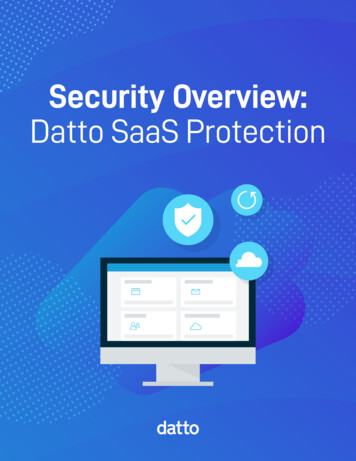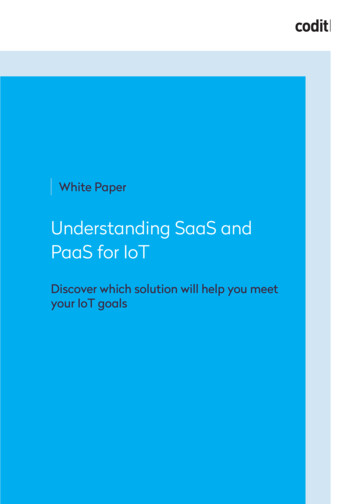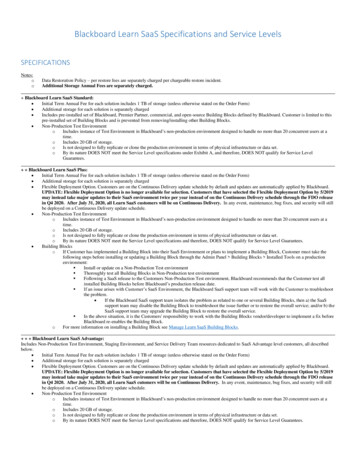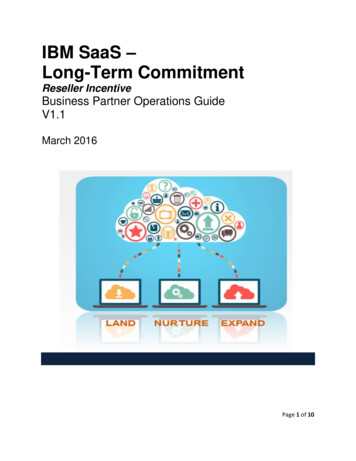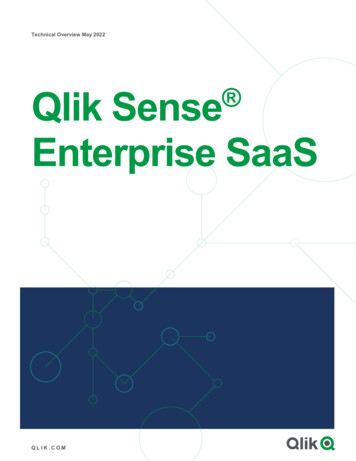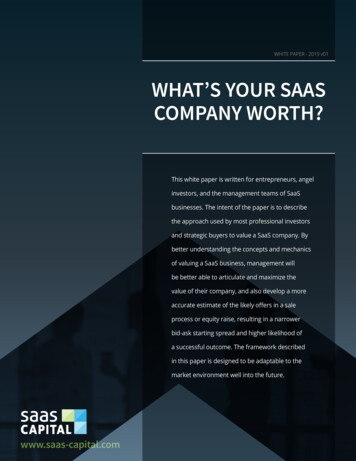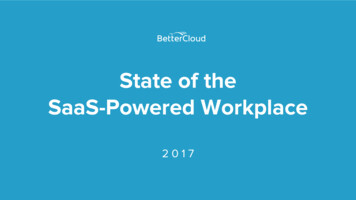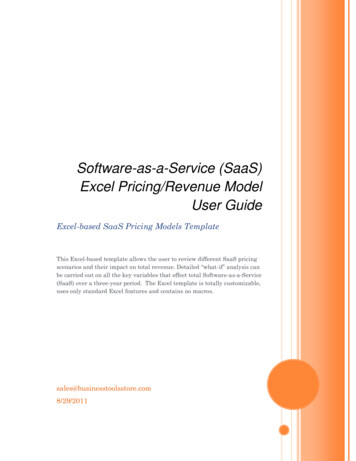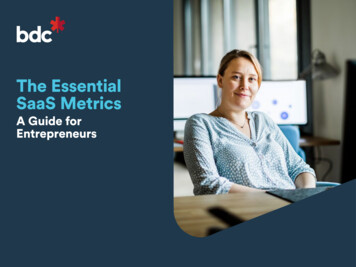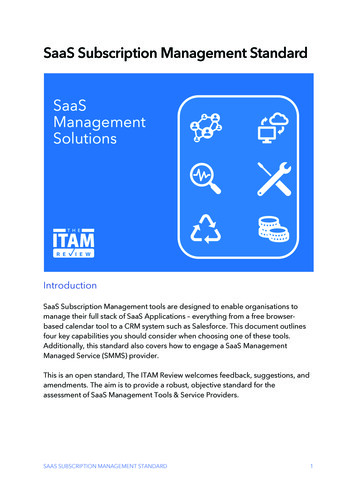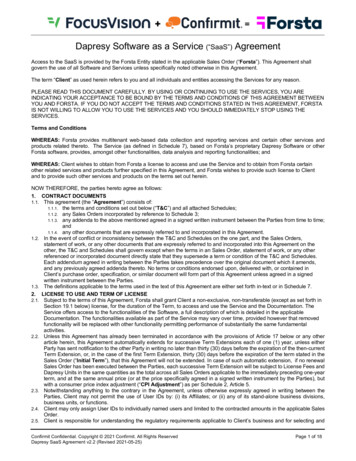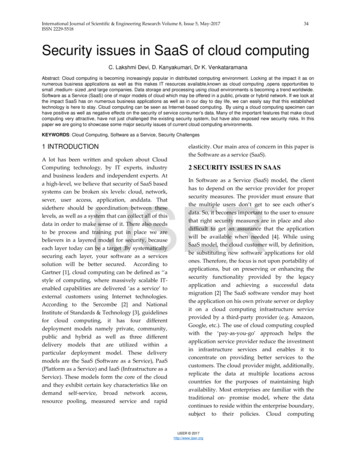
Transcription
International Journal of Scientific & Engineering Research Volume 8, Issue 5, May-2017ISSN 2229-551834Security issues in SaaS of cloud computingC. Lakshmi Devi, D. Kanyakumari, Dr K. VenkataramanaAbstract: Cloud computing is becoming increasingly popular in distributed computing environment. Locking at the impact it as onnumerous business applications as well as this makes IT resources available,known as cloud computing ,opens opportunities tosmall ,medium- sized ,and large companies. Data storage and processing using cloud environments is becoming a trend worldwide.Software as a Service (SaaS) one of major models of cloud which may be offered in a public, private or hybrid network. If we look atthe impact SaaS has on numerous business applications as well as in our day to day life, we can easily say that this establishedtechnology is here to stay. Cloud computing can be seen as Internet-based computing. By using a cloud computing specimen canhave positive as well as negative effects on the security of service consumer’s data. Many of the important features that make cloudcomputing very attractive, have not just challenged the existing security system, but have also exposed new security risks. In thispaper we are going to showcase some major security issues of current cloud computing environments.KEYWORDS: Cloud Computing, Software as a Service, Security Challenges1 INTRODUCTIONA lot has been written and spoken about CloudComputing technology, by IT experts, industryand business leaders and independent experts. Ata high-level, we believe that security of SaaS basedsystems can be broken six levels: cloud, network,sever, user access, application, anddata. Thatsidethere should be coordination between theselevels, as well as a system that can collect all of thisdata in order to make sense of it. There also needsto be process and training put in place we arebelievers in a layered model for security, becauseeach layer today can be a target .By systematicallysecuring each layer, your software as a servicessolution will be better secured. According toGartner [1], cloud computing can be defined as ‘‘astyle of computing, where massively scalable ITenabled capabilities are delivered ‘as a service’ toexternal customers using Internet technologies.According to the Sercombe [2] and NationalInstitute of Standards & Technology [3], guidelinesfor cloud computing, it has four differentdeployment models namely private, community,public and hybrid as well as three differentdelivery models that are utilized within aparticular deployment model. These deliverymodels are the SaaS (Software as a Service), PaaS(Platform as a Service) and IaaS (Infrastructure as aService). These models form the core of the cloudand they exhibit certain key characteristics like ondemand self-service, broad network access,resource pooling, measured service and rapidelasticity. Our main area of concern in this paper isthe Software as a service (SaaS).2 SECURITY ISSUES IN SAASIn Software as a Service (SaaS) model, the clienthas to depend on the service provider for propersecurity measures. The provider must ensure thatthe multiple users don’t get to see each other’sdata. So, it becomes important to the user to ensurethat right security measures are in place and alsodifficult to get an assurance that the applicationwill be available when needed [4]. While usingSaaS model, the cloud customer will, by definition,be substituting new software applications for oldones. Therefore, the focus is not upon portability ofapplications, but on preserving or enhancing thesecurity functionality provided by the legacyapplication and achieving a successful datamigration [2] The SaaS software vendor may hostthe application on his own private server or deployit on a cloud computing infrastructure serviceprovided by a third-party provider (e.g. Amazon,Google, etc.). The use of cloud computing coupledwith the ‘pay-as-you-go’ approach helps theapplication service provider reduce the investmentin infrastructure services and enables it toconcentrate on providing better services to thecustomers. The cloud provider might, additionally,replicate the data at multiple locations acrosscountries for the purposes of maintaining highavailability. Most enterprises are familiar with thetraditional on- promise model, where the datacontinues to reside within the enterprise boundary,subject to their policies. Cloud computingIJSERIJSER 2017http://www.ijser.org
International Journal of Scientific & Engineering Research Volume 8, Issue 5, May-2017ISSN 2229-5518providers need to solve the common tion systems. At the same time, theyalso have to deal with other issues inherentlyintroduced by the cloud computing paradigmitself. In the following section, the SaaS securityissues have been categorized as traditional andnew cloud specific security challenges, for sake ofconvenience. Figure 1 shows the various securityissues in SaaS model which are discussed in thepaper.2.1 Traditional Security Challenges35The authentication and authorization applicationsfor enterprise environments may need to bechanged, to work with a safe cloud environment.Forensics tasks may become much more difficultsince the investigators may not be able to accesssystem hardware physically. The design proposedby Pratap Murukutla [5] allows user to use a singleset of credentials. They have proposed a solutionwith de-facto standards of open authorization inwhich there is a trust party auditor whichmaintains all the credentials and cloud providercan uniquely distinguish one user from other. Themodel proposed in the literature [6] verifies userauthenticity using two-step. Verification, which isbased on password, smartcard and out of band (i.e.strong two factors) authentication. In addition, thescheme also provides mutual authentication,identity management, session key establishment,user privacy and security against many popularattacks; however the formal security proofinghasn’t yet been formalized.IJSER2.1.2 AvailabilityFigure 1: Security Issues in SaaS D.kanyakumari,2nd year MCA ,KMMIPS, TirupatimailId:kanyaakhila@gmail.comC.Lakshmi Devi, 2nd year MCA, mDr. K.Venkataramana, Dept. of MCA, KMMIPS,Tiirupati, mailId:ramanakv4@gmail.com2.1.1Authentication and authorizationThe availability ensures the reliable and timelyaccess to cloud data or cloud computing resourcesby the appropriate personnel. The availability ofcloud service providers is also a big concern, sinceif the cloud service is disrupted; it affects morecustomers than in the traditional model. Forinstance, the recent disruption of the Amazoncloud service in the year 2011, took down anumber of websites including Reedit, Foursquare,and Quota.The SaaS application providers arerequired to ensure that the systems are runningproperly when needed and enterprises areprovided with services around the clock. Thisinvolves making architectural changes at theapplication and infrastructural levels to addscalability and high availability. Resiliency tohardware/software failures, as well as to denial ofservice attacks, needs to be built from the groundup within the application. At the same time, anappropriate action plan for business continuity andDisaster Recovery (DR) needs to be considered forany exigencies as per the guidance provided by [2].This is essential to ensure the safety oftheIJSER 2017http://www.ijser.org
International Journal of Scientific & Engineering Research Volume 8, Issue 5, May-2017ISSN 2229-5518enterprise data while maintaining minimaldowntime for the enterprises. With Amazon [7] forinstance, the Amazon Web Services (AWS) APIend points are hosted on the same Internet-scale,world-class infrastructure that supports theAmazon retail site. Standard Distributed Denial ofService (DDoS) mitigation techniques such assynchronous cookies and connection limiting areused. To further mitigate the effect to potentialDDoS attacks, Amazon maintains internalbandwidth that exceeds its provider-suppliedInternet bandwidth.2.1.3Data confidentialityConfidentiality refers to the prevention ofintentionalorunintentionalunauthorizeddisclosure of information. Confidentiality in cloudsystem is related to the areas of intellectualproperty rights, covert channels, traffic analysis,encryption, and inference. Cloud computinginvolves the sharing or storage of information onremote servers owned or operated by others, whileaccessing through the Internet or any otherconnections. Cloud computing services exist inmany variations, including data storage sites,video sites, tax preparation sites, personal healthrecord websites and many more. The entirecontents of a user’s storage device may be storedwith a single cloud provider or with multiplecloud providers. Whenever an individual, abusiness, a government agency, or any other entityshares information in the cloud, privacy orconfidentiality questions arise.36environments, where compromise of even a singlevirtual machine can affect all users on the samephysical server. Virtualization is one of the maincomponents of a cloud. But this poses majorsecurity risks. Ensuring that different instancesrunning on the same physical machine are isolatedfrom each other is a major task of virtualizationwhich is not met completely in today’s scenario.The other issue all popular VMMs that allowescaping from VM. Virtual machine monitorshould be ‘root secure’, meaning that no privilegewithin the virtualized guest environment permitsinterference with the host system. Somevulnerability has been found in all virtualizationsoftware which can be exploited by malicious, localusers to bypass certain security restrictions or gainprivileges. For example, the vulnerability ofMicrosoft Virtual PC and Microsoft Virtual Servercould allow a guest operating system user to runcode on the host or another guest operatingsystem. Vulnerability in Virtual PC and VirtualServer could allow elevation of privilege. Cloudproviders, therefore, might need to reconsidertraditional security concerns from different angles.IJSER2.1.4Virtual Machine SecurityIs the control of administrator on host and guestoperating systems? Current Virtual MachineMonitor (VMMs do not offer perfect isolation.Many bugs have been found in although the globaladoption of virtualization is a relatively a ture are evolving just as quickly [8]. Thehypervisor and virtual machines used in cloudproviders may also have vulnerabilities, asexemplified by [11]. Such vulnerabilities representan even more serious problem in multi-tenant2.2 Cloud Specific Security Challenges2.2.1 Information ent model, the sensitive data of eachenterprise continues to reside within the enterpriseboundary and is subject to its physical, logical andpersonnel security and access control policies.However, in the SaaS model, the enterprise data isstored outside the enterprise boundary, at the SaaSvendor end. Consequently, the SaaS vendor mustadopt additional security checks to ensure datasecurity and prevent breaches due to securityvulnerabilities in the application or throughmalicious employees. This involves the use ofstrong encryption techniques for data security andfine-grained authorization to control access to data.2.2.2 Network SecurityIn a SaaS deployment model, sensitive data isobtained from the enterprises, processed by theSaaS application and stored at the SaaS vendorIJSER 2017http://www.ijser.org
International Journal of Scientific & Engineering Research Volume 8, Issue 5, May-2017ISSN 2229-5518end. All data flow over the network needs to besecured in order to prevent leakage of sensitiveinformation. This involves the use of strongnetwork traffic encryption techniques such asSecure Socket Layer (SSL) and the Transport LayerSecurity (TLS) for security. In case of Amazon WebServices (AWS), the network layer providessignificant protection against traditional networksecurity issues, such as MITM (Man-In-TheMiddle) attacks, IP spoofing, port scanning, packetsniffing, etc. For maximum security, Amazon S3 isaccessible via SSL encrypted endpoints.2.2.3 Resource LocalityIn a SaaS model of a cloud environment, the endusers use the services provided by the cloudproviders without knowing exactly where theresources for such services are located, possibly inother legislative domains. This poses a potentialproblem when disputes happen, which issometimes beyond the control of cloud providers.Due to compliance and data privacy laws invarious countries, locality of data is of utmostimportance in much enterprise architecture [112].The European Union has issued a Directive95/46/EC to protect the user privacy at all costs[13].37promote the wide use of cloud computing, thesestandards bodies need to sit down and worktogether to establish common standards. Possible‘‘Inter-cloud’’ standards in the following domainsare needed to increase cloud interoperability andfree data movement among clouds:– Network architecture, – Data format, – Meteringand billing, – Quality of Service, – Resourceprovisioning, – Security, identity management andprivacy. As stated, there are many generalcomputing standards that may be reused in thecloud, but for the moment, there2.2.5Data SegregationMulti-tenancy is one of the major characteristics ofcloud computing. As a result of multitenancy,multiple users can store their data using theapplications provided by SaaS. In such a situation,data of various users will reside at the samelocation. Intrusion of data of one user by anotherbecomes possible in this environment. Thisintrusion can be done either by hacking throughthe loop holes in the application or by injectingclient code into the SaaS system. A client can writea masked code and inject into the application. Ifthe application executes this code withoutverification, then there is a high potential ofintrusion into other’s data. A SaaS model shouldtherefore ensure a clear boundary for each user’sdata. The boundary must be ensured not only atthe physical level but also at the application level.The service should be intelligent enough tosegregate the data from different users. Amalicious user can use application vulnerabilitiesto hand- craft parameters that bypass securitychecks and access sensitive data of other tenants.IJSER2.2.4 Cloud standardsTo achieve interoperability among clouds and toincrease their stability and security, cloudstandards are needed across different standarddeveloping organizations. For example, the currentstorage services by a cloud provider may beincompatible with those of other provider. In orderto keep their customers, cloud providers mayintroduce so called ‘‘sticky services’’ which createdifficulty for the users if they want to migrate fromone provider to the other, e.g., Amazon’s S3 isincompatible with IBM’s Blue Cloud or ed Management Task Force [14], StorageNetworking Industry Association [15], Open GridForum [16], Open Cloud Consortium [17] andOrganization for the Advancement of StructuredInformation Standards [18], and so forth. To2.2.6 Data AccessData access issue is mainly related to securitypolicies provided to the users while accessing thedata. In a typical scenario, a small businessorganization can use a cloud provided by someother provider for carrying out its businessprocesses. This organization will have its ownsecurity policies based on which each employeecan have access to a particular set of data. TheIJSER 2017http://www.ijser.org
International Journal of Scientific & Engineering Research Volume 8, Issue 5, May-2017ISSN 2229-5518security policies may entitle some considerations,wherein, some of the employees are not givenaccess to certain amount of data [19]. Thesesecurity policies must be adhered by the cloud toavoid intrusion of data by unauthorized users[20].The SaaS model must be flexible enough toincorporate the specific policies put forward by theorganization. The model must also be able toprovide organizational boundary within the cloudbecause multiple organization will be deployingtheir business processes within a single cloudenvironment.2.2.7Web application securitySaaS is software deployed over the internet and/oris deployed to run behind a firewall in local areanetwork or personal computer. The keycharacteristics include Network-based access to,and management of, commercially availablesoftware and managing activities from centrallocations rather than at each customer’s site,enabling customers to access application remotelyvia the Web. SaaS application development mayuse various types of software components andframeworks. These tools can reduce time-tomarket and the cost of converting a traditional onpremise software product or building anddeploying a new SaaS solution. Examples includecomponents for subscription management, gridcomputing software, web application frameworksand complete SaaS platform products. One of the‘‘must-have’’ requirements for a SaaS application isthat it has to be used and managed over the web.The software which is provided as a service residesin the cloud without tying up with the actual users.This allows improvising the software withoutinconveniencing the user. Security holes in the webapplications thus create a vulnerability to the SaaSapplication. In this scenario, the vulnerability canpotentially have detrimental impact on all of thecustomers using the cloud. The challenge withSaaS security is not any different than with that ofany other web application technology. Howeverone of the problems is that traditional networksecurity solutions such as network firewalls,network intrusion detection and prevention38systems (IDS & IPS), do not adequately addressthis problem. Web applications introduce newsecurity risks that cannot effectively be defendedagainst at the network level, and do requireapplication leveldefenses. The Open WebApplication Security Project has provided the tenmost critical web applications security threats.2.2.8 Data breachesSince data from various users and businessorganizations lie together in a cloud environment,breaching into the cloud environment willpotentially attack the data of all the users. In theVerizon Business breach report blog it has beenstated that external criminals pose the greatestthreat (73 percent), but achieve the least impact(30,000 compromised records), resulting in aVirtualization vulnerability [21].IJSER3 CURRENT SECURITY SOLUTIONSTheOpen Web Application Security Project (OWASP)maintains list of top vulnerabilities to cloud-basedor SaaS models which is updated as the threatlandscape there are several research workshappening in the area of cloud security. Severalgroups and organization are interested indeveloping security solutions and standards forthe cloud. The Cloud Security Alliance (CSA) isgathering solution providers, non- profits andindividuals to enter into discussion about thecurrent and future best practices for informationassurance in the cloud [11]. The Cloud Standardswebsite collects and coordinates information aboutcloud-related standards under development by thegroups changes [10]. The Open Grid Forumpublishes documents to containing security andinfrastructural specifications and information forgrid computing developers and researchers [13].The best security solution for SaaS applications isto develop a development framework that hastough security architecture. One simple solution,for UK businesses is to simply use in-house‘‘private clouds’’ .Pearson highlighted that thecurrent lack of transparency is preventing manyusers from reaping the true benefits of the cloud.For Identity and access management in the SaaS,has issued an Identity and Access ManagementIJSER 2017http://www.ijser.org
International Journal of Scientific & Engineering Research Volume 8, Issue 5, May-2017ISSN 2229-5518Guidance which provides a list of recommendedbest practices to assure identities and secure accessmanagement. Resource Locality and DataSegregation are the two key security challenges onwhich not much information is available in theexisting literature, which necessitates that this canbe further taken up for research.4 CONCLUSIONThere are numerous though advantages in using acloud-based system, there are yet many practicalissues which have to be sorted. Cloud computingis a disruptive technology with profoundimplications not only for Internet services but alsofor the IT sector as a whole. Still, severaloutstanding issues exist, particularly related toservice-level agreements (SLA), security andprivacy, and power efficiency. As described in thepaper, currently security has lot of loose endswhich scares away several potential users. Until aproper security module is not in place, potentialusers will not be able to leverage the true benefitsof this technology. This security module shouldcater to all the issues arising from all directions ofthe cloud. Every element in the cloud should beanalyzed at both the macro and micro level andsubsequently an integrated solution must bedesigned and deployed in the cloud to attract andretain the potential consumers. Until then, cloudenvironment will remain cloudy. In a cloud, wherethere are heterogeneous systems having a variationin their asset value, a single security system wouldbe too costly for certain applications and if there isless security then the vulnerability factor of someapplications like financial and military applicationswill shoot up. On the other side, if the cloud has acommon security methodology in place, it will be ahigh value asset target for hackers because of thefact that hacking the security system will make theentire cloud vulnerable to attack. In this paper anoverview of cloud computing service deliverymodel, SaaS along with the security challenges ,including both the traditional and cloud specificsecurity challenges ,associated with the model hasbeen presented A number of new challenges that isinherently connected to the new cloud paradigm39has also been deliberated in the paper. As securedata storage in cloud environment is a significantconcern which prevents many users from using thecloud, a practical solution to provide security andprivacy for user data, when it is located in a publiccloud, was also discussed in this paper. The needfor further work on various security mechanismshas also been highlighted, in order to providetransparent services that can be trusted by allusers.References[1] Heiser J. (2009) what you need to know about cloudcomputing security and compliance, Gartner, Research, IDNumber: G00168345.[2] Seccombe A., Hutton A, Meisel A, Windel A,Mohammed A, Licciardi A, (2009). Security guidance forcritical areas of focus in cloud computing, v2.1. CloudSecurity Alliance, 25 p.IJSER[3] Mell P, Grance T (2011) The NIST definition of CloudComputing. NIST, Special Publication 800– 145,Gaithersburg, MD[4] Choudhary V. (2007). Software as a service: implicationsfor investment in software development. In: Internationalconference on system sciences, 2007, p. 209.[5] Pratap Murukutla, K.C. Shet (2012).Single Sign On forCloud .In: International Conference on Computing Sciences,2012IEEE DOI 10.1109/ICCS.2012.66[6] Amlan Jyoti Choudhury, Pardeep Kumar,Mangal Sain,Hyotaek Lim, Hoon Jae-Lee(2011).A Strong UserAuthentication Framework for Cloud Computing. In: IEEEAsia -Pacific Services Computing Conference, 2011 IEEEDOI 10.1109/APSCC.2011.14 [7] Amazon Web zon.com/security Accessed: [January2013][8] Amazon. Amazon Elastic Compute Cloud (EC2). http://aws.amazon.com/ec2/ . Accessed: [December, 2012][9] Cloud Security Alliance. Security best practices for cloudcomputing,2010b http://www.cloudsecurityalliance.org [Accessed: July 2012].[10] Cloud Security Alliance (2012) SecaaS implementationguidance, category 1: identity and Access tyalliance.org/initiatives/secaas/SecaaS Cat 1 IAM Implementation Guidance.pdfIJSER 2017http://www.ijser.org
International Journal of Scientific & Engineering Research Volume 8, Issue 5, May-2017ISSN 2229-5518[11] Secunia. Xen multiple vulnerabilities; 2011. http://secunia.com/advisories/26986/ [Accessed on 22November 2012][12] Soft layer. Service Level Agreement and Master ServiceAgreement, 2009 /http: // www.softlayer.com/sla.htmlS[Accessed: October2012].[13] European Union. Directive 95/46/EC of the Europeanparliament and of the council of 24 October 1995 on theprotection of individuals with regard to the processing ofpersonal data and on the free movement of such data; 1995[14] DTMF, 2013.Distributed Management Task Force. http://www.dmtf.org/ . [Accessed: January 2013][15] SNIA. (2013).Storage Networking Industry Association. http://www.snia.org/ . [Accessed: January 2013][16] OGF, 2010.Open Grid Forum, http://www.ogf.org/[Accessed:August 2012][17]OCC,2013.OpenCloud http://www.opencloudconsortium.org/ .January 2013]Consortium.[Accessed:IJSER[18] OASIS, 2013.Organization for the Advancement ofStructured Information Standards. http://www.oasisopen.org/ .[Accessed:January2013]Cloud Computing Standards Too Many Doing Too Little[19] Kormann D, Rubin A. (2000) Risks of the passport singlesignon protocol. Computer Networks 2000; 33 (16): 51–8.[20] Blaze M, Feigenbaum J, Ioannidis J, Keromytis AD. Therole of trust management in distributed systems security,secure Internet programming, issues for mobile anddistributed objects. Berlin: Springer-Verlag; 1999.p.185–210[21] Cooper R. Verizon Business Data Breach security IJSER 2017http://www.ijser.org40
paper we are going to showcase some major security issues of current cloud computing environments. KEYWORDS: Cloud Computing, Software as a Service, Security Challenges . 1 INTRODUCTION . A lot has been written and spoken about Cloud Computing technology, by IT experts, industry and business leaders and independent experts. At a high-level, we .
